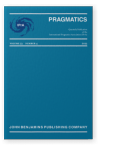Vol. 33:4 (2023) ► pp.505–531
The pragmatics of alternative futures in political discourses
Legitimising the politics of preemption in Trump’s discourse on Iran
We shall concentrate on how the construction and modality system of alternative futures in political discourses are influenced by the construal of past-to-present threats and preemptive politics. Using Dunmire’s (2005) proposed framework and further explorations by Cap (2020) on the subject, we approach twenty of Trump’s speeches on Iran, from 2017–2020. Our analyses indicated that the construction of alternative futures is modified by the evaluations of Iran’s past-to-present status and the politics of preemption. This relationship modifies the speaker’s epistemic judgment on the certainty of the privileged future, the cause-effect relation, and the sceptic views on the successful implementation of preemptive measures, resulting in the articulation of the privileged future through probabilistic and dynamic modalities. Moreover, the privileged future is conceptualised as necessary through deontic modality. By contrast, the realisation of the oppositional future is articulated through unmediated modality pinpointing the status that will materialise in light of inaction and negligence.
Article outline
- 1.Introduction
- 2.Review of literature
- 2.1The politics and ideology of future pre-configuration
- 2.2Alternative future and the politics of preemption
- 3.Analytical frameworks
- 3.1Analytical toolkits for alternative futures in political discourses
- 3.1.1Logico-rhetorical tools
- 3.1.2Lexico-grammatical and pragmatic properties
- 3.2Proximisation theory
- 3.1Analytical toolkits for alternative futures in political discourses
- 4.Methodology
- 5.Data analysis
- 5.1The now and past of Iran
- 5.2The preemptive policies
- 5.3The privileged future
- 5.4The oppositional future
- 6.Concluding remarks
-
References
